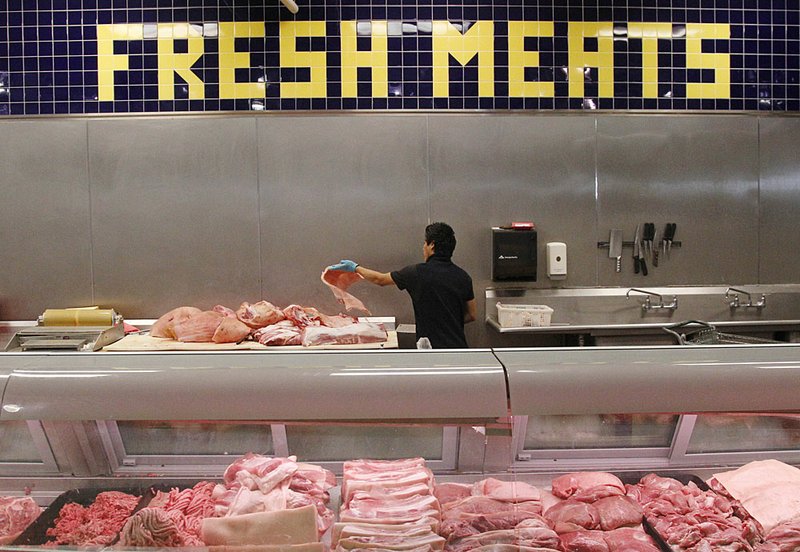MINNEAPOLIS — The drought gripping more than half the country is a big reason why consumers can expect to pay 3 percent to 4 percent more for groceries next year, the U.S. Department of Agriculture said this week.
Milk, eggs, beef, poultry and pork prices will all be affected because the drought is pushing up feed prices — which will eventually translate into higher prices for steaks, hamburger, pork chops and chicken. The good news for cost-conscious consumers is that prices for fruits and vegetables, as well as processed foods, won’t be affected as much by the drought.
Exactly how much more people will pay for a pound of hamburger, for example, isn’t known because those prices are affected by a variety of factors, such as how much of the increase any given supermarket might pass along to the consumer. But beef prices as a whole are expected to see the biggest jump at 4 percent to 5 percent, according to the USDA.
Dairy product prices are forecast to climb 3.5 percent to 4.5 percent; poultry and egg prices are projected to rise 3 percent to 4 percent; and pork prices are expected to rise 2.5 percent to 3.5 percent next year, the agency said.
“In 2013 as a result of this drought we are looking at above-normal food price inflation. ... Consumers are certainly going to feel it,” USDA economist Richard Volpe said.
Normal grocery price inflation is about 2.8 percent a year, Volpe said, so even a 3 percent increase is slightly higher than usual. The USDA kept its projected food price increase for 2012 steady at 2.5 to 3.5 percent, saying average retail food prices were flat for the first half of 2012 thanks to unusually low fruit and vegetable prices as well as lower prices for milk and pork.
The new forecasts are the agency’s first food price projections to factor in the drought, though experts have been warning for a few weeks that prices will rise.
As fields dry out and crops wither across much of the country’s midsection, prices for corn, soybeans and other commodities have soared in anticipation of tight supplies.
That means farmers and ranchers will have to pay more to feed their livestock — costs that are eventually passed on to consumers. Food prices typically climb about 1 percent for every 50 percent increase in average corn prices, according to agricultural economists.
Processed foods aren’t affected as much because feed costs don’t account for as much of their price tags. Fruits and vegetables aren’t expected to be any more costly because they are irrigated even in normal weather. The USDA is projecting an overall 2 to 3 percent increase for all fruits and vegetables next year, the same as it expects this year.
USDA economists were aware of the drought a month ago when they did their previous projections but didn’t know how bad it would get, Volpe said.
“This drought was a surprise for everybody,” Volpe said. “The USDA was forecasting a record year for the corn crop until this drought materialized. Now we’re not going to get that.”
The drought now covers about 60 percent of the continental United States, the largest area since the epic droughts of the 1930s and 1950s.
“It’s a disaster,” said Rick Tolman, chief executive officer of the National Corn Growers Association, who noted that farmers started out the season anticipating a record 14 billion bushel corn crop. The drought is expected to cut production by roughly 3 billion bushels. “We would have had adequate supplies, prices would have gone down. Instead we have the drought,” he said.
Scott Shellady, a commodities trader in Chicago, said the situation with the corn crop could affect other countries as well because U.S. food exports have increased dramatically in the past couple of decades.
“So we have an issue here where we have been feeding the world, but we’re going to have to slowly but surely dampen down those exports,” Shellady said.
Poultry prices will be the first to rise because chickens and turkeys need only a few months to grow to market size, Volpe said. Beef and pork take longer, and the agency revised its beef price projection for 2012 downward because producers are sending more cattle to the market as they reduce their herds in response to the drought, he said.
Processed food prices will be less affected because corn and other ingredients typically make up just a fraction of their production costs compared with expenses such as transportation and marketing.
Food companies are already reacting, even turning abroad in some cases to blunt the impact of higher corn prices and tight supplies. Smithfield Foods Inc., the world’s largest pork producer, has bought corn from Brazil, spokesman Keira Lombardo confirmed.
The drought is creating multiple problems for dairy farmers that consumers will eventually feel, said Ed Jesse, an emeritus professor of agricultural economics at the University of Wisconsin-Madison.
Farmers have begun culling their herds, which will mean less milk down the line. Also, cows give less milk in that heat, and the milk they do produce is lower in proteins and butterfat, Jesse said. That means cheese and butter prices are going up because it takes more milk to produce the same amounts.
Jesse predicted that milk prices for consumers will rise by 10 percent or more, and he expects those prices to stay high into next year until herds start to recover.
“I don’t think farmers are in a very happy state right now,” he said.
Information for this article was contributed by Dinesh Ramde and Sitthixay Ditthavong of The Associated Press.
Business, Pages 65 on 07/29/2012
